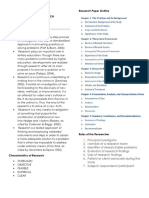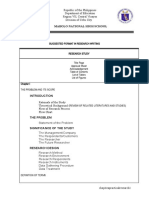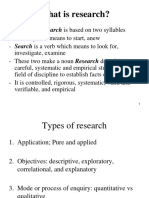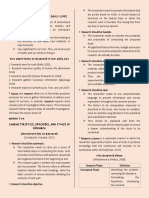Historical Research Design
Historical Research Design
Uploaded by
finesa.michaelangelouCopyright:
Available Formats
Historical Research Design
Historical Research Design
Uploaded by
finesa.michaelangelouOriginal Title
Copyright
Available Formats
Share this document
Did you find this document useful?
Is this content inappropriate?
Copyright:
Available Formats
Historical Research Design
Historical Research Design
Uploaded by
finesa.michaelangelouCopyright:
Available Formats
Historical research design Of external criticism and internal criticism; and
1.a. It refers to the overall strategy that the researcher choose to integrate the different 3. Presentation of the facts in readable form involving Problems and organization,
components of the study in a coherent and logical way, thereby, ensuring that the composition, exposition, And interpretation.
researcher will effectively address the research problem; it constitutes the blueprint
for the collection, measurement, and analysis of data.
Research design 4.Two (2) sources of historical research
2. It is a systematic and critical inquiry of the whole truth of past events using the primary sources
critical method in the understanding and the interpretation of facts which are secondary sources
applicable to current issues.
5.Two (2) primary sources of historical research in education
Historical research design
Documents
3.focuses at the present condition and its purpose is to find the new truth.
Remains
Descriptive research design
6.Three (3) examples of documents as a primary sources of historical research
4.it is a problem-solving approach that the study is described in the future on what
Memoranda
will be when certain variables are carefully controlled or manipulated.
Descriptive research design Circulars
5.a problem solving technique that the study is described from the past, present, and Laws
future.
Case study research 7.Three (3) examples of remains as a primary sources of historical research
6. According to funk and wagnalls in 1976, events, especially those involving human Apparatus
affairs.
Teaching aids
History
Devices.
7. In historical research evaluates the validity of the document - this is where, when,
and by Whom it was produced. 8.Two (2) examples of secondary sources of historical research
External criticism Histories of education
8. Evaluates the meaning, accuracy, and trustworthiness of the content of the Encyclopedias
document.
9.Give the importance of conducting historical research. (10 pts)
External criticism
-historical research is very important for several reasons. By looking at how people in
9. The following are advantages of conducting historical research except the past dealt with problems, we can find solutions for issues we face today. It helps
us understand why things are the way they are now by looking at their history. It gives
Historical research is limited to whatever data are available. us a sense of continuity and helps us see the link between the past and the present.
Knowing about our past helps communities understand and relate to current issues
10.the following are disadvantages of conducting historical research except better. Finally, it highlights important events and achievements from the past, making
us appreciate human efforts and progress.
There is no way, historical researcher cannot affect events of the
Ii. Enumeration. Answer as directed. (1 pt each)
1.Four (4) kinds of research design
historical design,
Descriptive design,
experimental design,
Case study design.
2.Uses of historical research
1. Historical research is useful in searching through the
Past for solutions to contemporary problems and needs.
2. It is used to throw light on the present.
3.Three (3) major steps of historical research
1. collection of data, with consideration of documents
And remains or relics of primary and secondary sources,
Of bibliographical procedure, and organization of
Materials;
2. Criticism of the data collected, including the processes
Descriptive research design 1. Types of descriptive research design
1.descriptive research design includes that purport to present facts concerning the Descriptive survey
nature and status of and standing facts that are going on. Anything. This means that -
it gives meaning to the quantify qualify Descriptive correlational survey
Quality Descriptive comparative
2.descriptive research is designed for the researcher to gather information about Descriptive-status.
conditions.
Descriptile analysis.
Present
Descriptive classification.
3.descriptive research seeks to tell "what exists" or "what is" about a certain
Descriptive normative survey
educational phenomenon. Accurate observations and assessments arise from the data
that ascertain the nature and incidence of prevalling conditions, practices or Normative survey
description of object, process, and person who are all objects of the study.
Descriptive-evaluative
Ascertain
4.it signifies the gathering of data regarding present conditions.
Survey
2.six (6) steps in conducting descriptive research
5.this approach is appropriate wherever the object of any class vary among
themselves and one is interested in knowing the extent to which different conditions Identify problem
obtain among these objects.
Review letterature
Descriptive survey
Select participants and instruments.
6.it is frequently made to ascertain the normal or typical condition (or practice), or to
compare local test results with a state or national norm. Collect valid and reliable data
Descriptive-normative survey Analyze data
7.this approach to problem solving seeks to answer questions to real facts relating to Conclusions.
existing conditions. This is a technique of quantitative description which determines 1.What are the common errors encountered in doing descriptive research?
the prevailing conditions in a group of cases chosen for the study. Lack of participant reponse
low response rates are common
Descriptive status unclear abiguous items
researcher needs to develop recording forms that collect the data objectively and
8.this method determines or describes the nature of an object by separating it into its reliably
parts. Its purpose is to discover the nature of things.
Descriptive survey descriptive-analysis 2. What are the importance of conducting descriptive research?
For a closer look into happpening, behavior, practice, methods and
9.this method is employed in natural sciences subjects such as botany, biology,
procedures.descriptive research provides essential facts and understanding about the
zoology, ichthyology, conchology and the like. The specimens collected are classified
nature of antything
from phylum to, species.
Descriptive-classification
10. This design is to appraise carefully the worthiness of the current study.
Descriptive-evaluative
11.it is a comparative survey where the researcher considers at least two entities (not
manipulated) and establishes a formal procedure for obtaining criterion data on the
basis of which he can compare and conclude which of the two is better.
Descriptive-comparative
12.this is designed to determine the relationship of two variables (x and y) whether
the relationship is perfect, very high, high, marked or moderate, slight, or negligible.
Correlational survey
13.this involves much time allotted for investigation of the same subjects at two or
more points in time.
Longitudinal survey correlational survey
14.the following are ethics of descriptive research except
Data should be manipulated.
15.the following are the importance of descriptive research design except
For the researcher to manipulate data
The three (3) types of pre-experimental design
Experimental research design One short case study
One group pretest/posttest
1. A type of research design which is defined as "observations under controlled one static group comparison
experimental research design 4. the three (3) cardinal feature of true experimental designs
In experimental research design, the researcher is an passive observer. Randomization
Active agent
Control
3 experimental designs are concerned with examination of the effect of an
independent variable on dependent variable, where the manipulated through treatment Manipulation.
or intervention. Dependent
5.6Advantages of true-experimental design
Independent
Casual claims can be investigated
4. In experimental research design, the independent variable is by the researcher.
Greater internal vaudity
Controlled
6.Disadvantages of true-experimental design
5 in experimental research design, the dependent variable is researcher.
not very practical.
Measured
Less external validity.
In experimental research design, if there is only one independent variable that can be
manipulated, then 7.Advantages of quasi-experimental design
Single-variable 22 greater external
In experimental research design, if there are two or more independent variables, and at 23. More feasible given time and logical contraints
least one can be manipulated, then a double-variable single-variable design should be
8.Advantages of pre-experimental design
chosen.
Very practical
Factorial
Set the stage for further research
8. The pre-experimental designs have variables. Degree of control maintained on
other
Low
The true experimental designs have variables. Degree of control maintained on other
High
10. The quasi-experimental designs have other variables. Degree of control
maintained on other variable
Medium
1.Threats to experimental research design
Internal validity
external validity
2.The three (3) classification of experimental research design as to single-variable
designs
Pre-experimental designs (low degree of control
True experimental designs (high degree of control)
quasi exprimenal degigns (medium degree of control)
3.The three (3) types of true experimental research design
Posttest control group design
Posttest only control group design
Solomon four group design
The three (3) types of quasi-experimental research design
Non equivalent control group
Time series
Multiple time series
18. It extends the cross site data analysis to include chronology as an organizing
variable.
Research design (case study)
1.case study is a qualitative research approach in which researchers focus on a unit of Time ordered meta matrix
study known as
19 it reveals relationships or association between two variables. Such relationships
Bounded system manifest them any non-random structure in the plot.
2.case study is a methodological choice and is a choice to be studied. True or false? Scatterplots
False 20. It is used by case study researchers to sort through the research sites and to display
probable effect relations.
3. A case study research method is appropriate when the researcher wants to answer
descriptive questio such as what happened? Or an explanatory question such as, how Cross site analysis strategies
and why did happen? True or false?
True
21. It extend the case study analysis and assist the case study researcher to identify
4.the following are the types of case study except how things go to
Extrinsic case study Time ordered meta matrix
5.it focuses on the case itself. The case presents an unusual or unique situation. 22.case study enables the experience to be studied and interpreted in depth. True or
false?
Intrinsic case study
True
6.it focuses on one issue. One bounded case is used to illustrate the issue. It helps to
refine a theory. 23. Case study has no potential to engage participants in the study. True or false?
Single instrumental case study False
7. It focuses on one issue or concern. Illustrate the issue. Explore differences within
and between cases.
24. A number of ways to make inferences
Multiple collective case study
True
8.the following are the characteristics of case study research except
Particularistic
Discuss briefly
9 a case study researcher may specifically choose a particular instance of phenomenon
1. How to apply case study research? (10 p) applying case study
under investigation to understand a specific problem that occurs in everyday practice.
to apply case study research, start by understanding the different types and purposes
Particularistic phenomenon of case studies and their origins to determine the most suitable approach for your
research. Next, decide on the specific type of case study you want to conduct,
10.the end result of the case study, the narrative, includes "thick description" of the including its purpose and the issues or questions it will address. Anticipate any
phenomenon, includin many variable and analyses of the interactions. potential difficulties you might face during the research and plan how to address them
effectively. Finally, present a convincing argument for why the case study method is
Descriptive phenomenon the most appropriate choice for your research topic.
11.it refers to the fact that case studies umsate the readers understanding of the study What are the steps in doing case study research?
beyond the readers' original knowledge. identify the case study approach: the researcher identifies a suitable case study
approach based on the research problem.
Heuristic phenomenon
select the case(s): the researcher selects a case or multiple cases to study.
12 the following are the factors to consider in designing a case study research except determine data collection methods: the researcher decides on the types of data to
determine the research question collect and the techniques for gathering this data.
analyze the data: the researcher selects the type of analysis, either holistic or
Spend much time in arguing a particular case study embedded, and develops a detailed description of the case, focusing on key issues.
interpret the findings: the researcher interprets the data to report the meaning of
13 the following are sample selection in case study except the case or lessons learned.
random sampling
14. The following are the screening procedures of the case study except
Spend much time in arguing a particular case study
15.a data management tool that enables the case study researcher to assemble master o
descriptive data from each site on one large sheet of paper.
Unordered meta matrix
16. Sites are ordered in a variable of interest so that the researcher can see the
differences.
Site ordered descriptive matrix
17. It moves the case study researcher from working descriptively/deductively to
explanatory/interpretive mode.
Site ordered predictor outcome matrix
You might also like
- Yin Case Study Research Design and Metho PDFDocument2 pagesYin Case Study Research Design and Metho PDFAnupNo ratings yet
- Kolb Learning Style InventoryDocument3 pagesKolb Learning Style Inventoryzayyadi_has100% (1)
- Hard Wiring Excellence SummaryDocument6 pagesHard Wiring Excellence Summarywacuff010% (1)
- Stages of Historical Methods of Research ConductingDocument3 pagesStages of Historical Methods of Research ConductingDenmarynneDomingoNo ratings yet
- Pras01a Quiz PDFDocument4 pagesPras01a Quiz PDFJan-Rhada AmarilaNo ratings yet
- Types of ResearchDocument17 pagesTypes of ResearchMiko Arianne Cruz MajaraisNo ratings yet
- Qualitative ResearchDocument2 pagesQualitative ResearchAthen Chelsea DuranNo ratings yet
- Research Methods Concept & IntroductionDocument8 pagesResearch Methods Concept & IntroductionDeepaNo ratings yet
- Eapp ReviewerDocument3 pagesEapp Reviewerchaybautista698No ratings yet
- Practical Research 1Document112 pagesPractical Research 1Nikka Marie Francisco100% (3)
- PR 1 ReviewerDocument7 pagesPR 1 ReviewerJAMES GAMERNo ratings yet
- General Forms of ResearchDocument25 pagesGeneral Forms of ResearchJa FloresNo ratings yet
- Methods of ResearchDocument11 pagesMethods of ResearchMichi OnozaNo ratings yet
- Res 1 - 3RD MasteryDocument11 pagesRes 1 - 3RD MasteryRhasher YbañezNo ratings yet
- Chapter Iii-Methods and Procedures 1Document14 pagesChapter Iii-Methods and Procedures 1Dexter BaretNo ratings yet
- Nature of Inquiry and Research: Some Research Ethics PrinciplesDocument11 pagesNature of Inquiry and Research: Some Research Ethics PrinciplesAlexander QuemadaNo ratings yet
- L1 - W1 - TPS211 - Introduction To Survey ResearchDocument24 pagesL1 - W1 - TPS211 - Introduction To Survey ResearchADREANA FARHANIM MOHD YUSOFNo ratings yet
- Introduction To Qualitative StudyDocument26 pagesIntroduction To Qualitative StudyDr. Muhammad Sofwan MahmudNo ratings yet
- Final Task Group 17 (Research Methodology)Document23 pagesFinal Task Group 17 (Research Methodology)ayuniNo ratings yet
- Practical Research 1 CompilationDocument68 pagesPractical Research 1 Compilationrence121701100% (1)
- Lesson 5 Communication For Academic PurposesDocument48 pagesLesson 5 Communication For Academic Purposesvlee3885No ratings yet
- RES Earch 2: First QuarterDocument7 pagesRES Earch 2: First QuarterAlexah QuezonNo ratings yet
- Bahan Ajar Metode Dan Teknik Penelitian Pendidikan QualitativeresearchDocument40 pagesBahan Ajar Metode Dan Teknik Penelitian Pendidikan QualitativeresearchStaff KOPMARTNo ratings yet
- AngeloDocument5 pagesAngeloRyan Cadorna Fontanilla100% (1)
- AR-149-RESEARCH-MODULE - Lesson 1 - 2Document10 pagesAR-149-RESEARCH-MODULE - Lesson 1 - 2Alexandra Joy LesiguesNo ratings yet
- MKBasher MPPG ThesisDocument52 pagesMKBasher MPPG ThesisNayeem SazzadNo ratings yet
- Lesson 1 EappDocument1 pageLesson 1 EappDesiree AlcantaraNo ratings yet
- MNGT 5. Research ModuleDocument133 pagesMNGT 5. Research ModuleLeynard ColladoNo ratings yet
- Qualitative Researchers Use:: The Characteristics of ResearchDocument5 pagesQualitative Researchers Use:: The Characteristics of ResearchErica Rose RamalesNo ratings yet
- Chan Module 1Document9 pagesChan Module 1Chan Gileo Billy ENo ratings yet
- Reviewer in Pr1 Qtr3Document2 pagesReviewer in Pr1 Qtr3Jovelle DiazNo ratings yet
- Lesson 1: The Nature of Research and The Research Process: Read To LearnDocument4 pagesLesson 1: The Nature of Research and The Research Process: Read To LearnIvan Karl LobatonNo ratings yet
- Learning Module in Practical Research 1Document5 pagesLearning Module in Practical Research 1Lyka FrancessNo ratings yet
- RDL ReviewerDocument10 pagesRDL ReviewerGweneth WajeNo ratings yet
- Criminological Research & Statistics: Pagadian Capitol CollegeDocument7 pagesCriminological Research & Statistics: Pagadian Capitol CollegeDon JunNo ratings yet
- Group 1 - ResearchDocument18 pagesGroup 1 - ResearchJasper CahuluganNo ratings yet
- Perpertual Succour Academy, Inc.: Teacher-Made Learner's Home TaskDocument7 pagesPerpertual Succour Academy, Inc.: Teacher-Made Learner's Home TaskCry BeroNo ratings yet
- Reviewer Practical Research 1Document7 pagesReviewer Practical Research 1justpassingbyNo ratings yet
- Chapter 1 IntroDocument11 pagesChapter 1 IntroJohnjoseph VeraNo ratings yet
- Research ReviewerDocument10 pagesResearch ReviewerSolstice OshiroNo ratings yet
- Reviewer in ResearchDocument5 pagesReviewer in ResearchvclentrayNo ratings yet
- PR1 Chapter 5 Lesson 1Document43 pagesPR1 Chapter 5 Lesson 1Jag Boy GarciaNo ratings yet
- Quantitative Research DesignDocument34 pagesQuantitative Research DesignIrwan PrayudhiNo ratings yet
- Qualitative ResearchDocument52 pagesQualitative Researchhjaromptb97% (32)
- 4منهج بحث تخصصي م3 ك2Document96 pages4منهج بحث تخصصي م3 ك2Helen ZakiNo ratings yet
- Reviewer in PR1 - QTR3Document2 pagesReviewer in PR1 - QTR3John Gil GomezNo ratings yet
- Research MethodologyDocument125 pagesResearch MethodologyVELUSAMY MNo ratings yet
- Criminological Research & Statistics: Pagadian Capitol CollegeDocument9 pagesCriminological Research & Statistics: Pagadian Capitol CollegeJay-r Pabualan DacoNo ratings yet
- Research MethodDocument81 pagesResearch MethodAisa karatuan100% (3)
- Research in Daily Life 1 - ReviewerDocument6 pagesResearch in Daily Life 1 - Reviewerdivinegrace.cruz.mnlNo ratings yet
- Research and Statistics HandoutsDocument13 pagesResearch and Statistics HandoutsPearl Ann RojasNo ratings yet
- REVIEWER Research in PsychologyDocument8 pagesREVIEWER Research in PsychologyFRANCISCO, Patrice T.No ratings yet
- TASK 2 - de La Cruz, Julius M.Document7 pagesTASK 2 - de La Cruz, Julius M.Rodel EstebanNo ratings yet
- Psy315 - Lesson 4Document21 pagesPsy315 - Lesson 4Faith BernadetteNo ratings yet
- MethodologyDocument22 pagesMethodologyhoormohameed2019No ratings yet
- Research Methodology and Scientific Writing (Chem 591) 1 Cr. HRDocument90 pagesResearch Methodology and Scientific Writing (Chem 591) 1 Cr. HRTariku TemesgenNo ratings yet
- PR 1 Module 2Document26 pagesPR 1 Module 2olivaresjirah7No ratings yet
- Creed Review Center: Sociology of Crimes & Ethics With Human Relations Criminological Research and StatisticsDocument10 pagesCreed Review Center: Sociology of Crimes & Ethics With Human Relations Criminological Research and StatisticsCarlo Tayanes100% (1)
- Research AptitudeDocument22 pagesResearch AptitudePRIYA SINGHNo ratings yet
- The Paradox of Positivism: Securing Inherently Insecure BoundariesDocument10 pagesThe Paradox of Positivism: Securing Inherently Insecure BoundariesSahar IdrisNo ratings yet
- Business Modelling: A Practical GuideDocument11 pagesBusiness Modelling: A Practical GuideCapraru IoanNo ratings yet
- Module Assessment2 C4Document19 pagesModule Assessment2 C4Loger Kent Bernabe100% (1)
- Reflection Note 1 Reading Program Objective 8Document1 pageReflection Note 1 Reading Program Objective 8JuliusSarmientoNo ratings yet
- Gr3.Health Teachers Guide JPDocument186 pagesGr3.Health Teachers Guide JPWii GabrielNo ratings yet
- LESSON PLAN Back TranslationDocument3 pagesLESSON PLAN Back TranslationGelli Rose Saludo0% (1)
- Course Outline 0452 Accounting IGCSEDocument5 pagesCourse Outline 0452 Accounting IGCSEAditi MishraNo ratings yet
- Memory How To Develop Train and Use ItDocument62 pagesMemory How To Develop Train and Use ItPlayboyNo ratings yet
- Module One: The Learning ContextDocument16 pagesModule One: The Learning Contexttups1224No ratings yet
- The Unconscious in Zen Buddhism - D. T. SuzukiDocument10 pagesThe Unconscious in Zen Buddhism - D. T. SuzukiDiana BarahonaNo ratings yet
- Dual Process Theories in Moral PsychologyDocument422 pagesDual Process Theories in Moral PsychologyMaria Beatrice100% (2)
- Chapter 2 Defining The Research ProblemDocument17 pagesChapter 2 Defining The Research ProblemGeleta AmanNo ratings yet
- Mahesh PuducheriDocument22 pagesMahesh PuducheriRamon Correia100% (1)
- Emplobility Skills Combined Best Top Rankers MaterialDocument70 pagesEmplobility Skills Combined Best Top Rankers MaterialRahul SinghNo ratings yet
- Gecsts Module 5 Agustin, April Joy B. Bped-1BDocument3 pagesGecsts Module 5 Agustin, April Joy B. Bped-1BApril joy AgustinNo ratings yet
- Expert L5 An Module 03Document2 pagesExpert L5 An Module 03tranvietcuongNo ratings yet
- Learning Area Grade Level Quarter Date: English 8 FourthDocument4 pagesLearning Area Grade Level Quarter Date: English 8 FourthStudent ServicesNo ratings yet
- Department of Education: Lesson Plan in Science IiiDocument8 pagesDepartment of Education: Lesson Plan in Science IiiWenna Grace OdtujanNo ratings yet
- Macro StrategyDocument5 pagesMacro StrategySCDownsNo ratings yet
- 29417140-Leadership Case StudyDocument7 pages29417140-Leadership Case Studyaleena javaid100% (3)
- Near-Death Experience ResearchDocument40 pagesNear-Death Experience Research王永成No ratings yet
- Module 1 (Society Web Community)Document2 pagesModule 1 (Society Web Community)Jason PahilanNo ratings yet
- B2+ Study Skills Answer KeyDocument1 pageB2+ Study Skills Answer KeyOlgaNo ratings yet
- Sample Title Thesis English EducationDocument4 pagesSample Title Thesis English Educationafknojbcf100% (2)
- 10 Things You Can Do To Boost Self-Confidence PDFDocument4 pages10 Things You Can Do To Boost Self-Confidence PDFSujith100% (1)
- SurveyInstrumentValidationRatingScale PDFDocument4 pagesSurveyInstrumentValidationRatingScale PDFGrace MañaleNo ratings yet
- Research Proposal Framework FormDocument1 pageResearch Proposal Framework Formapi-506227705No ratings yet
- Thesis Declaration by CandidateDocument7 pagesThesis Declaration by Candidategbtrjrap100% (2)

























































































